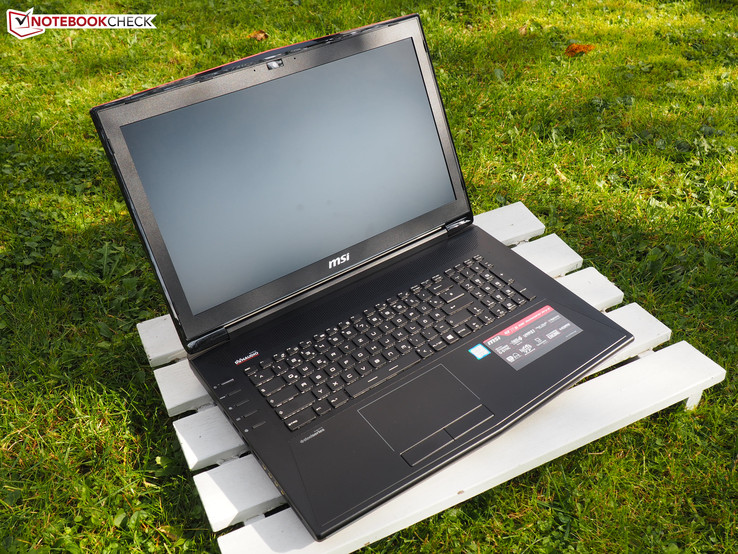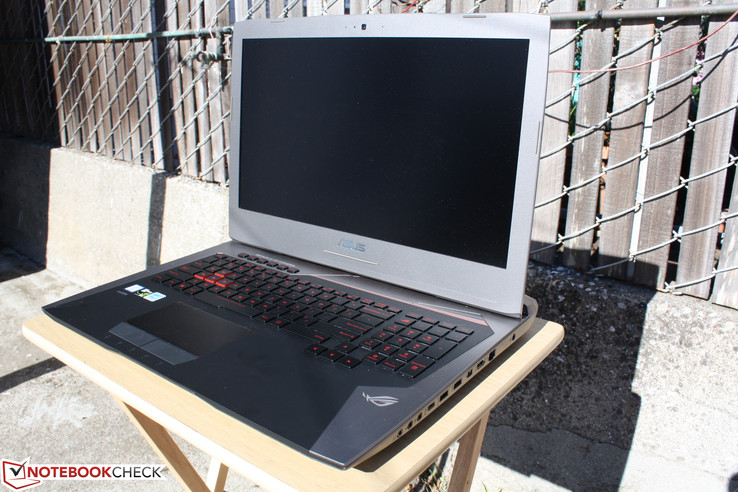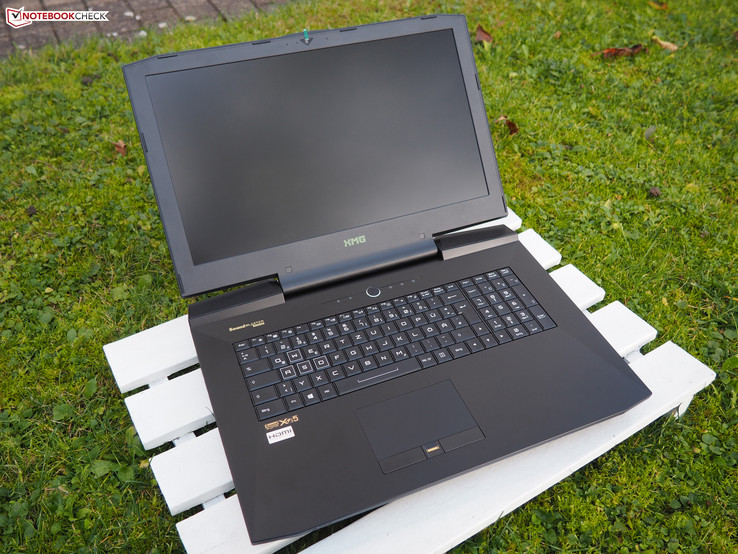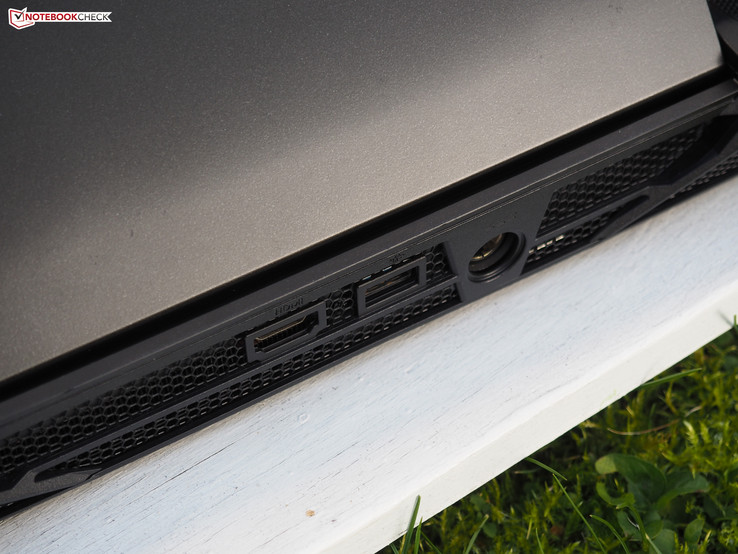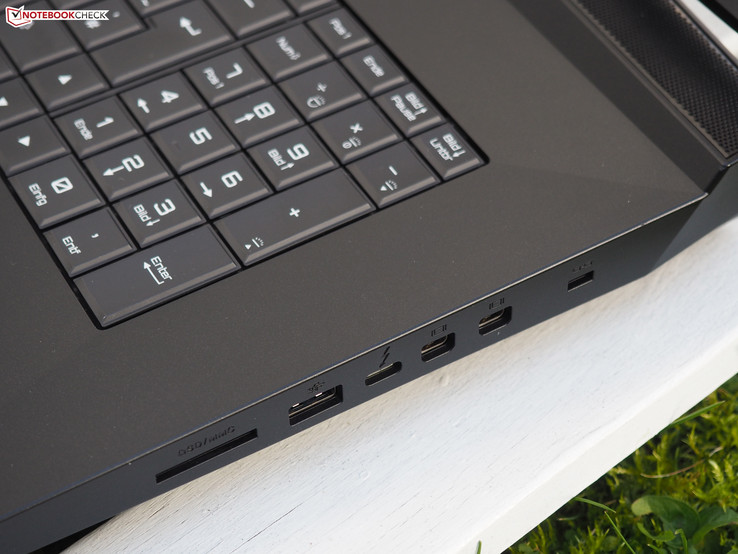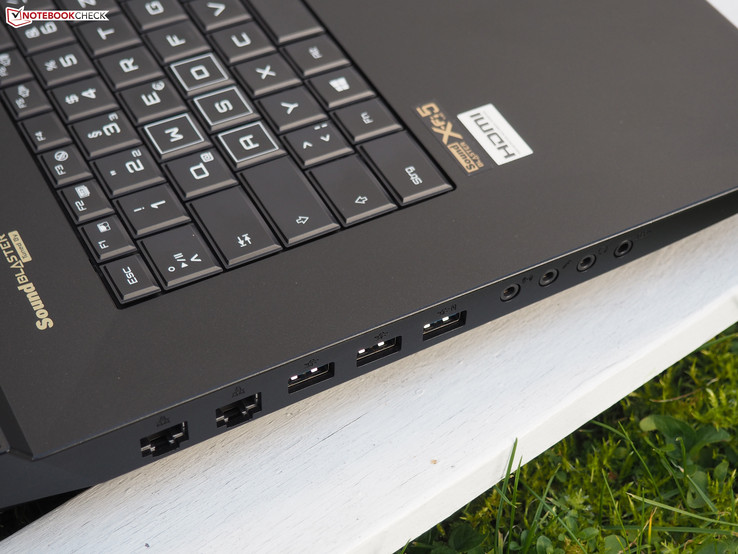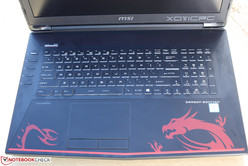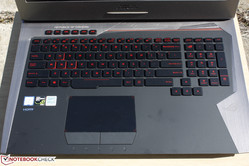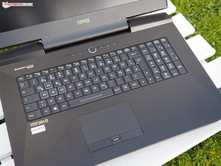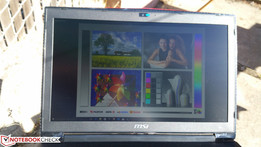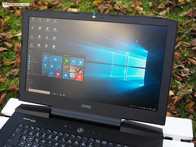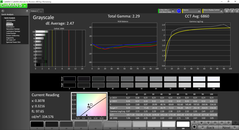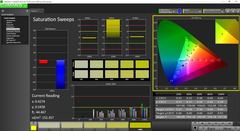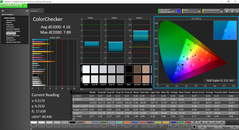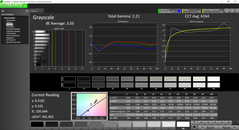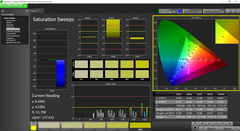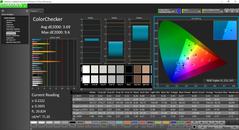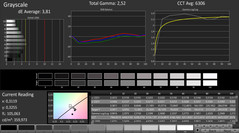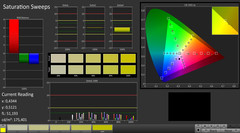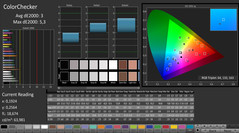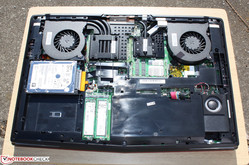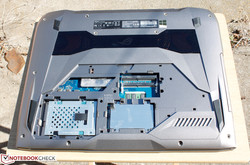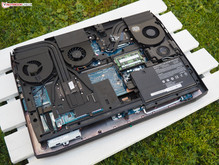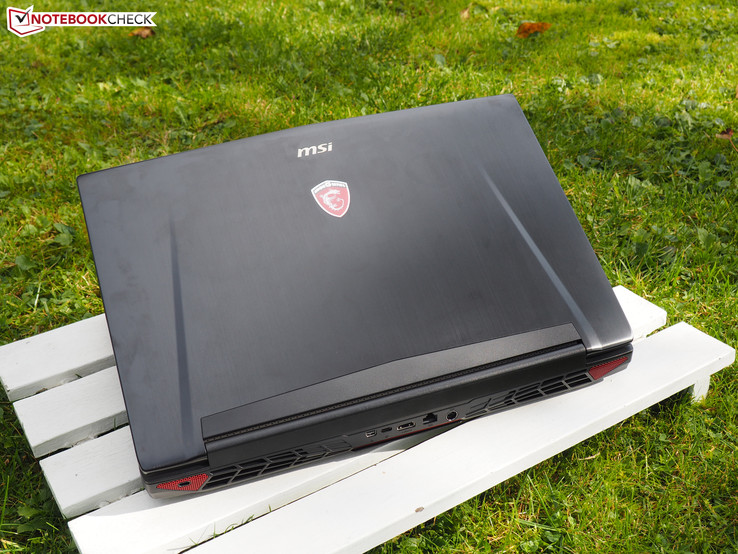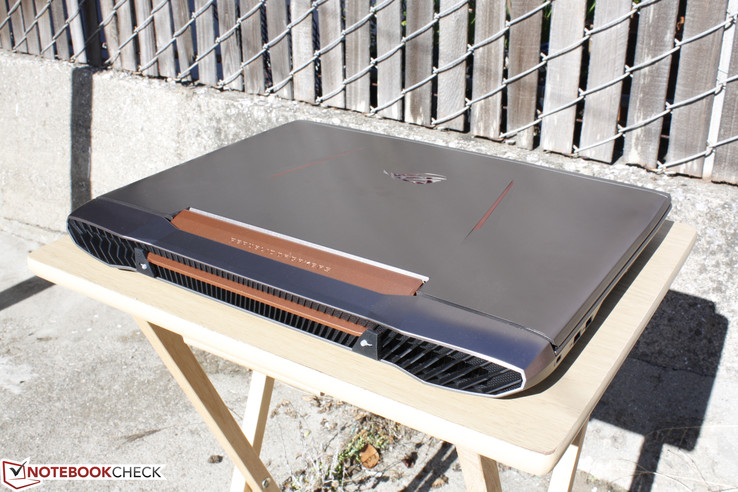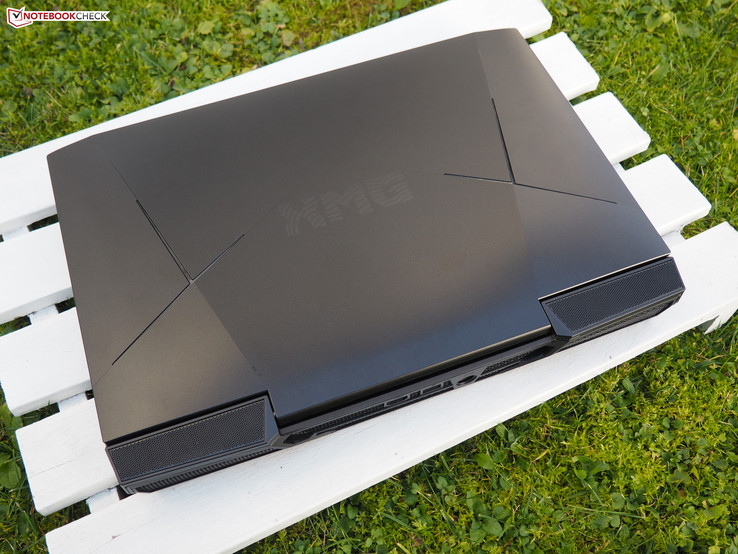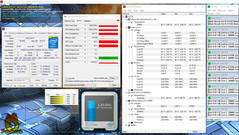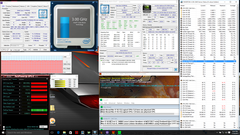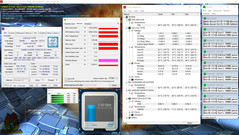Face Off: MSI GT72S vs. Asus G752 vs. Clevo P870DM

Now that Skylake and the GTX 980 for notebooks are out in the wild, how do the latest models sporting the new hardware compare to one another?
We check out the top three latest 17.3-inch gaming notebooks currently available with different configurations and specifications for each. If you're in the market for a high-end gaming notebook, then this short Face Off will be right up your alley.
We encourage users to check out our dedicated review pages below for more data and detailed analyses of each of the three models. This comparison is by no means a replacement, but a condensed aid for those on the fence.
Case
Any notebook worth thousands will better last for a long time. Thankfully, all three gaming machines here have excellent workmanship with none we can consider average or subpar. We can only nitpick on the smaller details for best in category.
The GT72S is the lightest and thickest with brushed aluminum and matte plastic for the lid and base. While the chassis itself is rigid, the hinges are weaker than we would have liked. We are able to hear slight creaking on our test model as well when opening or closing the lid. The display can be opened all the way up to 180 degrees unlike on the more limiting G752 (~120 degrees) and Clevo P870DM.
The G752 is thinnest, but also the longest in terms of depth. The additional girth is dedicated to the rear "jet engine" ventilation grilles that give the ROG series its signature style. There's no doubt that the G752 has the sharper and flashier design. While case quality is as good as the previous generation G751, the G752 has much more potential for gaps and manufacturing defects as its chassis is made up of smaller pieces instead of just a few larger cuts of plastic or aluminum like on the MSI or Clevo. The lid is more susceptible to twisting and depressions and the base itself can creak ever so slightly from applied pressure.
Lastly, the Clevo P870DM is by far the heaviest at just over 5 kg compared to 3.8 kg and 4.1 kg of the MSI and Asus, respectively. It must, after all, accommodate both a desktop CPU and GTX 980 with the option for SLI. The matte ABS plastic base and smooth aluminum lid are comparable in quality to the GT72S, if not slightly lower as the skeleton itself is not as thick.
Judging on case quality alone, the slight edge goes to MSI as we feel it will have fewer issues down the line when upgrading or tinkering with the internals. It's true that the Clevo is more serviceable, so it's still a close toss-up between the MSI and Clevo. Meanwhile, the difficult accessibility and repairability of the G752 automatically put Asus at the bottom.
Winner: MSI GT72S
Connectivity
Ports and hardware features abound on gaming notebooks. To start, each model sports USB Type-C 3.1 Gen. 2 capable of Thunderbolt 3 speeds (40 Gb/s). The GT72S carries the most USB 3.0 ports at six compared to just four on the Asus. The Clevo has the most dedicated video-out ports at three or four if including the versatile USB Type-C port. It is also the only notebook of the three to not have an internal optical drive for better or for worse.
Storage options are most plentiful on the GT72 with its 4x M.2 slots, 2.5-inch SATA bay, and ODD bay. Both the Clevo and Asus have half the M.2 slots, though the former has 2x 2.5-inch SATA bays to compensate. The G752 is also the only one with no RAID 0 support.
Winner: MSI GT72S
| MSI GT72S | Asus G752 | Clevo P870DM | |
| USB | 6x USB 3.0, 1x USB 3.1 Gen. 2 Type-C | 4x USB 3.0, 1x USB 3.1 Gen. 2 Type-C + Thunderbolt 3 | 5x USB 3.0, 1x USB 3.1 Gen. 2 Type-C + Thunderbolt 3 |
| Video-out | 1x HDMI, 1x mDP | 1x HDMI, 1x mDP | 1x HDMI, 2x mDP |
| Other | SD reader, optical drive, 4x 3.5 mm audio, Gigabit Ethernet, Kensington Lock | SD reader, optical drive, 3x 3.5 mm audio, Gigabit Ethernet, Kensington Lock | SD reader, 4x 3.5 mm audio, 2x Gigabit Ethernet, Kensington Lock |
| Storage Bays | 2x NVMe M.2, 2x M.2, 1x 2.5-inch SATA III, 1x SATA I ODD | 2x NVMe M.2, 1x 2.5-inch SATA III, 1x SATA I ODD | 2x NVMe M.2, 2x 2.5 inch SATA III |
Input Devices
Key feedback is softer and quieter on the MSI, so the pressure point for each key is spongier than on the Asus and Clevo. It's not terrible and users can certainly grow accustomed to it over time. The Clevo offers slightly more satisfying feedback and is one of the few gaming notebooks alongside the Alienware series to still use the beveled layout. Unfortunately, the system offers no auxiliary keys or dedicated macro keys as on the MSI and Asus, respectively.
The Asus keyboard offers the firmer feedback of the three. The layout and feel are identical to the G751, so no significant changes have been made for this latest iteration.
As for the touchpads, Asus has the largest in surface area (12.0 x 6.8 cm) compared to the MSI (10.8 x 6.1 cm) and Clevo P870DM (11.0 x 6.0 cm). The touchpad of the MSI is slightly rubberized with no texture separation between it and the palm rests. Asus has the smoother touchpad out of the three, but its dedicated mouse keys are much spongier in comparison. The Clevo is the only one with a fingerprint reader that is often overlooked on many gaming notebooks.
The touchpads are at a tie for functionality and response, so the larger one on the Asus takes the lead. Keyboard feedback and travel are again marginally better on the Asus.
Winner: Keyboard -- Asus ROG G752
Touchpad -- Asus ROG G752
Display
Unlike the Clevo, the GT72S and G752 SKUs do not carry display resolutions above 1080p at the time of writing. Additionally, the Clevo model includes options for much deeper colors and at least 95 percent sRGB coverage. This makes it the undisputed choice over the Asus and MSI for professional graphic designers who demand precision colors. For gaming, however, the advantage here is not significant. G-sync is standard on both the G752 and GT72S while it is completely absent on the UHD panel for the Clevo.
Contrast and brightness are a bit higher on the GT72S. On the flip side, it also suffers from slightly more backlight bleeding than on the Asus or Clevo. Choosing an objective winner in this category is impossible because of the unique pros and cons of each panel. Users can choose based on which properties they find are most important.
Winner: Tie
| MSI GT72S | Asus G752 | Clevo P870DM | |
| Size | 17.3-inch IPS matte | 17.3-inch IPS matte | 17.3-inch IPS matte |
| Native Resolution | 1920 x 1080 | 1920 x 1080 | 3840 x 2160 |
| Pixel Density | 127 PPI | 127 PPI | 255 PPI |
| Panel ID | LG Philips LP173WF4-SPF1 | LG Philips LP173WF-SPF3 | AU B173ZAN01.0 |
| MSI GT72S 6QF | Asus G752VT | SCHENKER XMG U726 | |
|---|---|---|---|
| Display | |||
| Display P3 Coverage (%) | 67.6 | 66.3 | 87 |
| sRGB Coverage (%) | 86.1 | 84.5 | 100 |
| AdobeRGB 1998 Coverage (%) | 63 | 61.8 | 98.9 |
| Response Times | |||
| Response Time Grey 50% / Grey 80% * (ms) | 43 ? | 30.4 ? | |
| Response Time Black / White * (ms) | 29 ? | 27.2 ? | |
| PWM Frequency (Hz) | |||
| Screen | |||
| Brightness middle (cd/m²) | 356.7 | 357.2 | 330 |
| Brightness (cd/m²) | 326 | 339 | 327 |
| Brightness Distribution (%) | 85 | 89 | 86 |
| Black Level * (cd/m²) | 0.282 | 0.366 | 0.38 |
| Contrast (:1) | 1265 | 976 | 868 |
| Colorchecker dE 2000 * | 4.16 | 3.69 | 3 |
| Greyscale dE 2000 * | 2.47 | 3.05 | 3.81 |
| Gamma | 2.29 96% | 2.21 100% | 2.52 87% |
| CCT | 6860 95% | 6164 105% | 6306 103% |
| Color Space (Percent of AdobeRGB 1998) (%) | 56 | 55 | 88 |
| Color Space (Percent of sRGB) (%) | 85 | 84 | 100 |
| Colorchecker dE 2000 max. * | 5.3 | ||
| Total Average (Program / Settings) |
* ... smaller is better
Performance
CPU Performance
MSI, Asus, and Clevo all offer multiple CPU options beyond what we have here, so this comparison is only between the configurations on hand. We have three different CPUs and GPUs to compare, which should produce a nice range of results and characteristics.
The desktop CPU in the Clevo is significantly more power-hungry than the mobile Core i7 CPUs in the Asus and MSI. While the Clevo is the outright winner in raw CPU performance, the performance gaps between it and the Asus and MSI are actually narrower than one would expect. CineBench results are only a few percentage points ahead of the i7-6820HK in stock speeds and roughly 20 percent ahead of the i7-6700HQ in the Asus.
See our dedicated CPU pages on the Core i7-6820HK and i7-6700HQ for more comparisons and benchmarks.
| MSI GT72S | Asus G752 | Clevo P870DM | |
| CPU | 2.7 GHz Core i7-6820HK | 2.6 GHz Core i7-6700HQ | 3.4 GHz Core i7-6700 |
| TDP | 45 W | 45 W | 65 W |
| RAM | 16 GB DDR4 2133 MHz, Dual-channel, 4x SODIMM slots | 16 GB DDR4 1066 MHz, Dual-channel, 4x SODIMM slots | 32 GB DDR4 2133 MHz, Dual-channel, 4x SODIMM slots |
| GPU | Nvidia GeForce 980M (Manual graphics switch) | Nvidia GeForce 970M (No graphics switch) | Nvidia GeForce 980 (No graphics switch) |
| Cinebench R15 | |
| CPU Single 64Bit (sort by value) | |
| MSI GT72S-6QEG16SR421BW | |
| Asus G752VT | |
| SCHENKER XMG U726 | |
| CPU Multi 64Bit (sort by value) | |
| MSI GT72S-6QEG16SR421BW | |
| Asus G752VT | |
| SCHENKER XMG U726 | |
| Cinebench R11.5 | |
| CPU Single 64Bit (sort by value) | |
| MSI GT72S-6QEG16SR421BW | |
| Asus G752VT | |
| SCHENKER XMG U726 | |
| CPU Multi 64Bit (sort by value) | |
| MSI GT72S-6QEG16SR421BW | |
| Asus G752VT | |
| SCHENKER XMG U726 | |
| Cinebench R10 | |
| Rendering Single CPUs 64Bit (sort by value) | |
| Asus G752VT | |
| Rendering Multiple CPUs 64Bit (sort by value) | |
| Asus G752VT | |
| wPrime 2.10 | |
| 1024m (sort by value) | |
| Asus G752VT | |
| 32m (sort by value) | |
| Asus G752VT | |
| Super Pi Mod 1.5 XS 32M - 32M (sort by value) | |
| Asus G752VT | |
| SCHENKER XMG U726 | |
| 3DMark | |
| 1280x720 offscreen Ice Storm Unlimited Physics (sort by value) | |
| Asus G752VT | |
| 1920x1080 Ice Storm Extreme Physics (sort by value) | |
| Asus G752VT | |
| 1280x720 Cloud Gate Standard Physics (sort by value) | |
| MSI GT72S-6QEG16SR421BW | |
| Asus G752VT | |
| SCHENKER XMG U726 | |
| 1920x1080 Fire Strike Physics (sort by value) | |
| MSI GT72S-6QEG16SR421BW | |
| Asus G752VT | |
| SCHENKER XMG U726 | |
| Fire Strike Extreme Physics (sort by value) | |
| Asus G752VT | |
| PCMark 8 | |
| Storage Score (sort by value) | |
| Asus G752VT | |
| Work Score Accelerated v2 (sort by value) | |
| Asus G752VT | |
| SCHENKER XMG U726 | |
| Creative Score Accelerated v2 (sort by value) | |
| Asus G752VT | |
| SCHENKER XMG U726 | |
| Home Score Accelerated v2 (sort by value) | |
| Asus G752VT | |
| SCHENKER XMG U726 | |
| X264 HD Benchmark 4.0 | |
| Pass 1 (sort by value) | |
| SCHENKER XMG U726 | |
| Pass 2 (sort by value) | |
| SCHENKER XMG U726 | |
* ... smaller is better
GPU Performance
The GTX 980 is roughly 40 percent ahead of the GTX 980M in the MSI and 70 percent ahead of the GTX 970M in the Asus according to 3DMark 11 and Fire Strike standard.
| 3DMark 11 - 1280x720 Performance GPU (sort by value) | |
| MSI GT72S-6QEG16SR421BW | |
| Asus G752VT | |
| SCHENKER XMG U726 | |
| 3DMark | |
| 1280x720 offscreen Ice Storm Unlimited Graphics Score (sort by value) | |
| Asus G752VT | |
| 1920x1080 Ice Storm Extreme Graphics (sort by value) | |
| Asus G752VT | |
| 1280x720 Cloud Gate Standard Graphics (sort by value) | |
| MSI GT72S-6QEG16SR421BW | |
| Asus G752VT | |
| SCHENKER XMG U726 | |
| 1920x1080 Fire Strike Graphics (sort by value) | |
| MSI GT72S-6QEG16SR421BW | |
| Asus G752VT | |
| SCHENKER XMG U726 | |
| Fire Strike Extreme Graphics (sort by value) | |
| Asus G752VT | |
| Cinebench R11.5 - OpenGL 64Bit (sort by value) | |
| MSI GT72S-6QEG16SR421BW | |
| Asus G752VT | |
| SCHENKER XMG U726 | |
| Cinebench R15 - OpenGL 64Bit (sort by value) | |
| MSI GT72S-6QEG16SR421BW | |
| Asus G752VT | |
| SCHENKER XMG U726 | |
Gaming Performance
The jump from a GTX 980M to the GTX 980 compared to a GTX 970M to the GTX 980M is just slightly larger despite the near doubling of TDP (~100 W vs 165 - 200 W). Whether or not the marginal increase in frame rates is worth the much higher power demands, however, is up to the user.
See our dedicated GPU pages for the GTX 970M, GTX 980M, and GTX 980 for more comparisons and benchmarks.
| Batman: Arkham Knight | |
| 1920x1080 High / On (Interactive Smoke & Paper Debris Off) AA:SM AF:8x (sort by value) | |
| MSI GT72S-6QEG16SR421BW | |
| Asus G752VT | |
| Clevo P870DM | |
| 1920x1080 High / On AA:SM AF:16x (sort by value) | |
| MSI GT72S-6QEG16SR421BW | |
| Asus G752VT | |
| Clevo P870DM | |
Stress Test
To test system stability, we run both Prime95 and FurMark to simulate maximum stress. These unrealistic conditions do not represent daily workloads, but are instead meant to put both the CPU and GPU at 100 percent capacity.
All three notebooks perform very well under extreme stress with no major throttling of the CPU or GPU. Turbo Boost and GPU Boost can be maintained indefinitely, though at much higher levels on the GT72S compared to the Asus or Clevo. The base CPU and GPU clock rates on the Clevo are already very high anyway, so it benefits less from Turbo Boost relative to the Asus or MSI. Additionally, core temperatures reach higher levels on the more powerful Clevo despite its oversized cooling solution.
Our Clevo configuration takes the crown from a pure performance point-of-view. The cost comes at higher temperatures overall and less overclocking headroom.
Winner: Clevo P870DM
| MSI GT72S | Asus G752 | Clevo P870DM | |
| Rated GPU Core Clock (MHz) | 1038 | 924 | 1190 |
| Stable GPU Core Clock on FurMark (MHz) | 848 | 886 | 1163 |
| Rated CPU Core Clock (GHz) | 2.7 | 2.6 | 3.4 |
| Stable CPU Core Clock on Prime95 (GHz) | 3.3 | 3.1 | 3.5 |
| Maximum CPU temperature | 96 C | 85 - 90 C | 99 C |
| Maximum GPU temperature | 84 C | 73 C | 87 C |
Emissions
System Noise & Temperature
Fan noise is always audible on each of the three systems no matter the onscreen load. The GT72S is the quieter notebook at about 30 dB(A) compared to 33 to 34 dB(A) on the Asus and Clevo, respectively, but its fans tend to pulsate more frequently as a result. This behavior can be bothersome if the user is simply browsing or watching videos.
When under similar maximum loads, the three notebooks produce nearly identical fan noise at about 46 dB(A). The story becomes different during gaming loads as the MSI and Asus will each settle in the 35 to 37 dB(A) range while the Clevo can be as loud as 42 dB(A). Thus, headphones are recommended when gaming on the Clevo for a less distracting experience.
A noteworthy advantage on the Clevo is its deeper fan controls. Users have more freedom over fan speed settings for normal loads (video playback, browsing), gaming loads, and maximum speed if desired. The MSI notebook includes a Turbo Fan mode that will immediately bump fan noise up to 50 dB(A) and higher, but with no options in between.
Surface temperatures are lowest on the Asus even after taking into account the cool ambient temperature. Its average surface temperature barely rises at all at just 28 C compared to 39 C and 43 C on the MSI and Clevo, respectively. Hot spots still form, but they are very localized on the Asus and are far away from the palm rests and most of the keyboard. It's fitting that the least powerful notebook of the three provides the quieter fan noise and lower temperatures all-around.
Winner: Asus ROG G752
| MSI GT72S | Asus G752 | Clevo P870DM | |
| Fan Noise when idling | 30.6 dB(A) | 33.0 dB(A) | 34.0 dB(A) |
| Fan Noise under high loads | 46.0 dB(A) | 45.8 dB(A) | 46.0 dB(A) |
| Average surface temperature when idling | 29.2 C | 26.8 C | 35.2 C |
| Average surface temperature under high loads | 39.3 C | 28.1 C | 43.3 C |
| Ambient temperature | 22 C | 19 C | 22 C |
Battery Life
Battery life is lowest on the Asus due to the lack of Optimus and its smaller battery capacity. The manual graphics switch gives the MSI an edge over Asus and Clevo when activated. Otherwise, battery life is short across the board.
Winner: MSI GT72S
| MSI GT72S-6QEG16SR421BW 83 Wh | Asus G752VT 67 Wh | SCHENKER XMG U726 89 Wh | |
|---|---|---|---|
| Battery Runtime | |||
| Reader / Idle (h) | 4.4 | 3.8 | 2.8 |
| Load (h) | 1.2 | 1.2 | 1.6 |
| WiFi v1.3 (h) | 3.1 |
Verdict
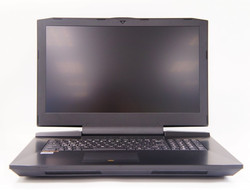
The winner of this Face Off should excel in the three categories we feel are most important to the notebook gamer: Performance, upgradeability, and connectivity. Buyers will want the full power of the notebook and the freedom to upgrade components at will while having plenty of options for connecting external devices and monitors.
The Asus G752 can be crossed off our list as it carries fewer ports, less user-friendly accessibility, and more fixed components. It's far from being a poor gaming notebook, but its longevity is inferior to the more modular GT72S and Clevo P870DM. Our test model runs cooler and quieter out of the three notebooks partly due to its weaker hardware. The extra performance and vapor cooling may help give it longer legs should users choose to purchase a higher-end SKU, but upgradeability remains subpar especially for its size and category.
It's a difficult choice between the GT72S or Clevo P870DM. The MSI carries extra storage bays and G-Sync, but includes no options for 2K or 3K resolutions. The Clevo has the more color accurate and higher resolution display with better fan controls and SLI support, but with no G-Sync, no optical drive, louder fan noise, and fewer storage bays.
For pure gaming purposes, either the GT72S or P870DM will more than suffice as the GTX 980 GPU is available on both systems. However, the superior colors and resolution advantage on the Clevo make it more appealing to gamers who also do professional graphics work.
| MSI GT72S | Asus G752 | Clevo P870DM |
|---|---|---|
+ Strong build quality + 6x USB 3.0 ports + 6x storage bays + Manual graphics switch + Longer battery life + Upgradeable GPU + Higher contrast | + Lower fan noise + Lower surface/core temperatures + Thinner profile + G-Sync standard + More comfortable keyboard and larger trackpad + Five macro keys | + Thinner and lighter + Better fan controls + Upgradeable desktop CPU and GPU + Higher resolution options above 1080p + Wider color gamut |
- CPU not upgradeable - Slightly weaker chassis - No macro keys - Thicker - Fans pulsate more frequently | - Longer in length - No RAID 0 - Limited display angle (~120 degrees) - No graphics switching - No CPU or GPU upgrade options | - Heavier - Louder system fans - Lower screen brightness and contrast - No optical drive - Higher temperatures under load - No graphics switching - No macro keys |
MSI GT72S
Price comparison
Asus G752
Price comparison
Clevo P870DM
Price comparison
See more quick comparisons in our Face Off series:
- Dell XPS 15 vs. Apple MacBook Pro 15 vs. Asus ZenBook Pro UX501
- Aorus X3 Plus vs. Gigabyte P34W vs. Razer Blade 14
- Dell XPS 13 vs. Apple MacBook Pro 13 vs. Asus ZenBook UX305
- HP EliteBook 820 G2 vs. Lenovo ThinkPad X250 vs. Dell Latitude 12 E7250
- Asus ROG G751 vs. Dell Alienware 17 vs. MSI GT72 Dominator
- Lenovo ThinkPad T450 vs. Acer TravelMate P645 vs. Dell Latitude 14 E5450
- Dell Alienware 15 vs. Clevo P751ZM vs. MSI GE62
- Acer Aspire V17 Nitro vs. Asus N751 vs. HP Envy 17
- Samsung Galaxy Tab S 8.4 vs. Sony Xperia Z3 Compact vs. Dell Venue 8 7000
- Asus EeeBook X205TA vs. Lenovo S20 vs. Acer Aspire ES1
- Microsoft Surface Pro 3 vs. Asus Transformer Book T300 Chi vs. Toshiba Portege Z20t
- Lenovo ThinkPad Edge E550 vs. Acer Aspire E5 vs. HP ProBook 450 G2
- HP Pavilion 15 vs. Lenovo IdeaPad Z50 vs. Toshiba Satellite S50
- Apple MacBook Air 13 2015 vs. Samsung ATIV Book 9 900X3G vs. Asus ZenBook UX303
- Asus ROG G501 vs. Lenovo Y50 vs. Acer Aspire V15 Nitro
- OnePlus 2 vs. Honor 6 Plus vs. Motorola Moto X Play
- Lenovo Yoga 500 vs. Dell Inspiron 15 7000 vs. Toshiba Satellite Radius 15
- Apple iPhone 6S Plus vs. Huawei Mate S vs. LG G4
- Dell Inspiron 15 5558 vs. Lenovo Z51 vs. Acer Aspire V3 574G




